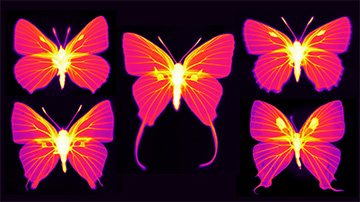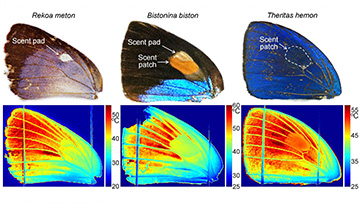A Columbia–Harvard team used hyperspectral imaging to create detailed infrared images of the wings of butterfly species, such as these from the family Lycaenidae. The intensity is proportional to thermal emissivity, and shows that living parts of the wings (wing veins and scent pads) have elevated thermal emissivity, allowing these parts to better dissipate heat via thermal radiation. [Image: Nanfang Yu] [Enlarge image]
Butterflies and their colorful, gossamer wings have long inspired artists, poets and other creative types. Now, physicists led by Nanfang Yu of Columbia University, USA—in a collaborative study with Harvard University, USA, entomologist Naomi Pierce—say that they, too, are gaining inspiration from butterfly wings that might inform engineering applications such as thermal management, mechanical sensing and hyperspectral imaging (Nat. Commun., doi: 10.1038/s41467-020-14408-8).
For their study, the researchers set out to investigate the thermodynamic and thermoregulatory properties of the butterfly wing. They examined the living tissues of the butterfly wing and identified the physical and behavioral adaptations that modulate wing temperatures in ways that protect these delicate tissues especially from overheating in the sun.
Complex networks
“Research on butterfly wing patterns has focused on the visible range of the spectrum,” says Pierce, who is also curator of Lepidoptera for Harvard’s Museum of Comparative Zoology. “This study shows that we need to take into account the full electromagnetic spectrum as well as the underlying network of living tissues in order to understand the patterns found on butterfly wings.”
Butterfly wings, Yu explains, have a network of veins to conduct both hemolymph—insect blood—and air, as well as a matrix of mechanical and temperature sensilla distributed along wing veins. Each vein contains two channels for hemolymph and a tracheal tube to carry air. The vein network maintains a sort of tidal flow of hemolymph and air over the insect’s lifetime, as a volume increase for the tracheal tube results in a decrease in volume for the hemolymph channels, and vice versa.
Wings can also host living tissue that plays a role in sexual reproduction. The wings of males from certain species of hairstreak butterflies contain so-called androconial organs—membrane-covered scent pads or scale-covered scent patches that generate and release pheromones used to influence the behavior of females. Unlike the wing vein network, scent pads are bathed in a unidirectional flow of hemolymph that is drawn through the organ by the regular beating of a tiny “wing heart,” positioned in the wing near the bottom right hand corner of the organ.
“Bad” thermodynamics
Intricate and essential as they are, butterfly wings have “bad thermodynamics,” according to Yu. “They have small thermal capacity and can overheat rapidly in the sun. We found that to counteract this disadvantage, a butterfly wing has substantially lower solar absorption in the near-infrared than in the visible. Since sunlight has about half of its power in the near-infrared, a substantially lowered near-infrared absorption helps to reduce the overall temperature of the wings.”
To study the thermodynamics of the butterfly wing, Yu says, the research team developed an infrared hyperspectral-imaging technique that permits accurate mapping of the wing temperature. The researchers used a mid-infrared microscope and a Fourier transform infrared spectrometer to assess emissivity, transmissivity and reflectivity across the entire wing with a resolution comparable to individual wing scales. The resulting hyperspectral data enabled the team to process thermal camera read-outs to tease out the contribution that was due solely to infrared flux produced by the wing and subsequently to derive the wing temperature distribution.
Cooling off
Temperature distributions on the forewing of three species of Eumaeini butterflies illuminated by sunlight, Despite wide variation in visible wing coloration and pattern, the temperature of the scent patches, pads and wing veins that contain living cells is always lower than that of the remaining “non-living” parts of the wings. [Image: Nanfang Yu and Cheng-Chia Tsai/Columbia Engineering] [Enlarge image]
The hyperspectral-imaging studies showed that different parts of the butterfly wing have dramatically different thermal emissivities. The scent pad, scent patch and wing veins all have emissivities approaching unity—perfect for heat dissipation through thermal radiation.
Scent patch scales were by far the most emissive, Yu says, because of unique nanostructures of their scales. For the scent pads and wing veins, heightened thermal emissivity stems from thickened, chitinous layers of membrane. As a result of the regionally and selectively enhanced thermal emissivity, he says, the living parts of the wing can stay as much as 20 degrees cooler than the rest of the wing.
“We found that under all simulated environmental conditions that mimic the living environment of butterflies, the areas of the wings that contain living cells—the wing veins and the androconial organs—are cooler than the ‘lifeless’ membranous regions of the wing, and we believe that this is because the living parts of the wing need to be kept in a suitable thermal metabolic window in order to function properly,” Pierce says. “Now that we have the tools to be able to measure more accurately the temperature of these thin and delicate structures, we can begin to understand the thermodynamics of the wings themselves.”
The researchers also found that butterflies can effectively use their wings as a vector light-detecting panel to quickly determine the intensity and direction of sunlight, responding with specialized behaviors to prevent overheating.
Working transparently
The infrared hyperspectral-imaging technique developed in this study can be applied to objects, like butterfly wings, that are both lightweight and translucent to determine their temperature distribution and chemical composition, which would have many biomedical, forensic, and other applications, Yu says.
For an applied physicist, the butterfly wing offers some intriguing possibilities for sensory-mechanical designs. “The fact that each wing is equipped with a few dozen mechanical sensilla for the robustness and accuracy in mechanical sensing is really inspiring,” says Yu. “Perhaps we shall reexamine the sensory network used in airplane wings and create bioinspired, robust, and multifunctional sensory networks that can detect the external environment and the internal state of the wings.”
Yu’s scientific interest in butterflies and moths stems from his days as a Harvard University postdoc. He approached Pierce with an idea to study the feathery antennae of male moths, which to him looked more like waveguides that could perceive signals in the near-infrared. Pierce says she was intrigued by the idea and so they wrote up a grant application to the U.S. National Science Foundation. The two got the grant and started a line of highly interdisciplinary research centered upon the interactions between insects and their electromagnetic environment.
The researchers say they intend to continue the current collaboration to study wings and wavelengths, but to extend it to include some 500 species, with a goal of differentiating various biological and physical factors that contribute to the structure, coloration, and pattern of wings.


